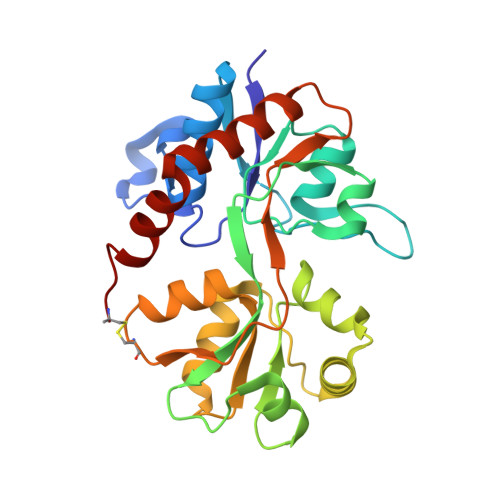Mechanisms of Modal Activation of GluA3 Receptors.
Poon, K., Ahmed, A.H., Nowak, L.M., Oswald, R.E.(2011) Mol Pharmacol 80: 49-59
- PubMed: 21464198
- DOI: https://doi.org/10.1124/mol.111.071688
- Primary Citation of Related Structures:
3RT6, 3RT8, 3RTF, 3RTW - PubMed Abstract:
AMPA receptors are the major excitatory neurotransmitter receptors in the central nervous system and are involved in numerous neurological disorders. An agonist-binding site is present in each of four subunits that form a functional channel. Binding consists of three steps: docking of agonist to the bilobed ligand binding domain (LBD), closure of the LBD, and increased stability of the closed-lobe conformation through interlobe hydrogen bonding. We describe GluA3 single channel currents activated by nitrowillardiine (NO(2)W) and chlorowillardiine (ClW) in the presence of cyclothiazide, in conjunction with crystal structures of GluA2 and GluA3 LBDs bound to fluorowillardiine (FW), ClW, and NO(2)W. When bound to NO(2)W or ClW, the GluA3 channel opens to three conductance levels with comparable open probabilities and displays modal behavior similar to that obtained with glutamate and FW as agonists (Poon et al., 2010). At lower concentrations, ClW evoked an alternate kinetic behavior, consisting of high open probability in lower conductance states. The structure of ClW bound to GluA3 LBD exhibits a unique partially open hydrogen bonding structure that may be associated with these alternative kinetics. NO(2)W evoked longer open times than seen for other agonists in high and very high modes. The structure ofGluA2 LBD bound to NO(2)W exhibits fully closed lobes with additional interlobe interactions mediated by the nitro group. Beyond differences in efficacy between full and partial agonists, the complexities of the single channel behavior of AMPA receptors may also be associated with small interactions that modify the stability of various degrees of closure.
Organizational Affiliation:
Department of Molecular Medicine, Cornell University, Ithaca, NY 14853, USA.
















